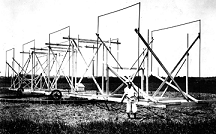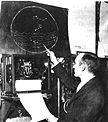 number is Courtesy National Oceanic and Atmospheric Administration Updated: more information |
 Solar activity undulates on an 11 year cycle.
At the "solar maximum" there are more solar flares,
more sunspots, more sun quakes, more of everything that solar
physicists love to study. But the solar cycle is not just for
academics -- it affects everyday life on Earth, sometimes in
unexpected ways. Northern lights have inspired art and poetry.
A new science was born earlier this century
thanks to the solar minimum. There's no evidence, but some people
claim that even the length of mini-skirts and the performance
of stocks are affected by sunspots. Solar activity undulates on an 11 year cycle.
At the "solar maximum" there are more solar flares,
more sunspots, more sun quakes, more of everything that solar
physicists love to study. But the solar cycle is not just for
academics -- it affects everyday life on Earth, sometimes in
unexpected ways. Northern lights have inspired art and poetry.
A new science was born earlier this century
thanks to the solar minimum. There's no evidence, but some people
claim that even the length of mini-skirts and the performance
of stocks are affected by sunspots. |
| This is your chance to draw your own conclusions. Using the plotter, below, you can graph the sunspot number around the time of any date you choose. A few historically interesting dates are listed in the sidebar, but you may enter any date you consider significant (even your birthday). If you find any interesting correlations let us know by emailing webmaster@sunspotcycle.com. |
|
Moments in History
For more information on current solar conditions visit The Space Weather Bureau |
Sunspot Plotter
(Java support required)
How do sunspots fit in to this story? This way: the earth's atmosphere has a layer called the "ionosphere" which is ionised by radiation from the sun. The ionosphere acts like a mirror. When a shortwave radio station transmits a signal, it reflects off the ionosphere rather than shooting off into space. Shortwaves can bounce many times and thus travel long distances around the globe. This is how ham radio operators can communicate over long distances. During solar maximum the ionosphere is relatively dense 24 hrs a day. Shortwave radio signals from the cosmos reflect off the ionosphere back into space, and terrestrial radio stations and other sources of static are trapped inside the ionosphere and cause a great deal of interference. Radio astronomers who observe at shortwave frequencies can attest that it's nearly impossible to observe cosmic radio sources during the sunspot maximum, especially during the daytime when the ionosphere is particularly dense. Only during a sunspot minimum are conditions suitable for astronomical observations. As fate would have it, Jansky's work was conducted during solar minimum. To see this, enter the date "01 Jan 1933" in the sunspot plotter above. His daytime observations of the Milky Way, conducted from 1932 through 1934, would likely have been impossible a few years earlier or later when solar activity was high. Thanks to Jansky's insight and the coincidence of the solar minimum a new window on the Universe was opened and radio astronomy was born.  This chart recording shows some of Jansky's observations of the Galactic Center (called "Sagitarius A" by astronomers). Jansky rotated his antenna 360 degrees around a circular track once every 20 minutes. When the antenna beam swung past the galactic center, which was low on the horizon at the time of these observations, a peak was recorded on the strip chart record. Note the times of day that the recordings were obtained -- in the late afternoon. Shortwave radio astronomy observations at that time of day, especially of an object low on the horizon, would normally be impossible. However, because the data were collected during a solar minimum, Earth's ionosphere was transparent, radio interference was low, and Jansky was able to make his historic observations. |
Back to Sunspots and The Solar Cycle
Copyright © 1998 Bishop Web Works
All rights reserved.
 Jansky, who had very little experience
in radio engineering, was nevertheless assigned the task of studying
trans-Atlantic radio interference. In 1930 he began work on the
antenna pictured right, and by 1931 Jansky was making regular
observations of radio static at a frequency of 20.5 MHz. The
"Jansky Antenna" doesn't look much like modern arials,
i.e., TV antennas or satellite dishes, because it was designed
to receive shortwave signals coming over the horizon.
Jansky, who had very little experience
in radio engineering, was nevertheless assigned the task of studying
trans-Atlantic radio interference. In 1930 he began work on the
antenna pictured right, and by 1931 Jansky was making regular
observations of radio static at a frequency of 20.5 MHz. The
"Jansky Antenna" doesn't look much like modern arials,
i.e., TV antennas or satellite dishes, because it was designed
to receive shortwave signals coming over the horizon. 